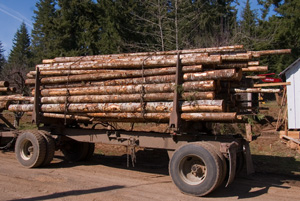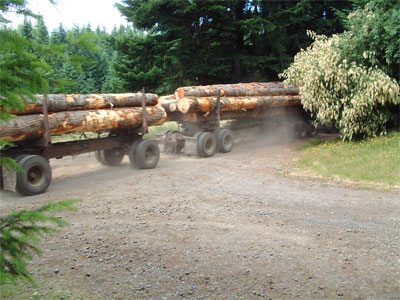



|
| 32 foot logs on Mule |

|
| General Trailer as Mule Train |

|
| Pre-Commercial Thinnings for Pulpwood |
The Nomenclature of the logging business is never easy. What you see in this photo is called a "mule train" You See a truck with 2 bunks on it, followed by a 4 wheel wagon with two bunks on it. This configuration is used for hauling 'short logs'. In this case, that would be logs typically from 12 feet to 24 feet long. Longer logs can actually be hauled on the trailer. The trailer body is 20 feet long. In Oregon the combination is legal to 75 feet total length, and with a 14 foot tongue to achieve the maximum weight allowed for the axles, --- now around 94,000 lbs (if the truck has a booster axle) the back of the trailer is at around 70 feet allowing the logs to stick out 4 feet on the back, and you can hang them out on the front of the trailer as far as you want (until they conflict with the logs on the truck or screw up the balance so bad you can't get a load.
Practically speaking we occasionally haul 32's on the trailer, although 20's are the handiest to haul. On the west coast 'super trucks' are becoming increasingly popular. In this configuration, you take the same 4 wheel wagon and put a short tongue on it and connect it to the back of a conventional log truck, or if hauling other materials, behind a semi-trailer. In this mode you create 'Rocky mountain doubles' consisting of a standard truck and trailer with a 4 wheel trailer on the back. You are allowed extra length (68 feet for the load carrying area) and can achieve weights with permits up to 105,500 lbs. If this same trailer is used as the second trailer in a set of doubles, it is called a "Pup"

|
| Double Trailer Configuration |
The challenge, of course, in the log hauling business with a set of doubles is not cruising the interstate. You have to get this conglomeration out into the woods, get it turned around in space that most people can't turn a car around in, get it headed toward town, get it loaded and then snake down a one track road until you find a highway for the rest of the trip to market.
Log truckers have traditionally handled this challenge by hauling their trailer out into the woods. This does a couple good things. It means that you don't need much space to turn around. It means that if you have to back up the last half a mile because there is no turn around you can do it, and, of course it gives the truck some ballast so you can actually get up the hill without spinning out on the rocks. Life gets a lot more interesting if you have 2 trailers. You can only haul one and have to drag the other. The way this is typically handled is counter intuitive. You haul the first trailer and drag the second trailer. The reason for this is this. You drive out into the woods (where the logs are) forward. Instead of turning around and backing to the loading area as you traditionally would, you drive into the loading area forwards (since dragging a trailer you can't turn around anyway.
Then the loader (shovel if you will) will take the trailer you are dragging and after unhooking it, will pick it up and set it out of the way. The truck driver then backs out of the loading area to where ever the turn around is, turns around, and backs back into the loading area. The first trailer is then unloaded, hitched to the back of the truck in the traditional manner and loaded. The loaded truck then pulls ahead while the shovel retrieves the second trailer which is than hitched up and loaded.
In the first photo, which was actually taken in about 1975, you see a Pettibone Cary-Lift which just unloaded the trailer. This is not the norm. Here the Pettibone functioned as a forklift and the teeth were simply placed under the trailer frame and the trailer lifted off the truck. More common in the woods is to use a 'shovel'---now actually an tracked excavator modified for loading logs such as the LinkBelt 4300 featured elsewhere on this site.
You have to know that General makes good trailers. The trailer you see here in the second photo as the 'pup' is the same trailer you see in the first photo taken in 1975. The difference is that this second photo is taken 31 years later in 2006. While conceptually the doubles are unwieldily, actually they are not as bad as they seem. While they are unusable where steep adverse grades of limited traction is available, they are not a problem on a crooked road. The front trailer is shortened to bunk 32's--shorter than the normal setting to bunk 36's. This shorter configuration makes the stinger steering on the first trailer more active all of which means that both trailers follow the truck very closely. The setup unlike a semi trailer, doesn't cut corners.